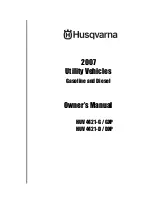
RT655 Operator’s Guide
Foreword
Page Issue A
Foreword
The Johnston RT655 Air Regen Sweeper represents the highest grade of craftsmanship and
reliability that makes Johnston probably the world leader in sweeping technology.
This machine is designed for the removal of spoil on traffic or pedestrian areas, and litter collection
using the Wanderhose [EN 13019 refers], and should only be driven by trained operatives.
This machine should not be used for sweeping hot or burning substances. In the unlikely event of
a fire, normal powder or foam fire fighting equipment can be used on this product.
An operator should receive training in the follow elements:
1 Safety Observations/Notices
2 Transit driving
3
Correct use of body prop
4
In cab controls
5
External controls
6
Sweeping techniques
7
Load discharge
8
Channel brush (gutter broom) setting changing
9
Nozzle (pick-up head) setting
10
Daily and weekly maintenance items
11
Driving/operation assessment
12
End of day cleaning of body and machine
Johnston Sweepers Limited can provide operator training upon request.
We would point out that it is the employers responsibility to carry out his own Risk Assessment on
the equipment in his particular working environment and work application.
This handbook should be carefully studied. In it you will find instructions for the operation and
maintenance of your JOHNSTON SWEEPER.
It is vitally important that the operator and maintenance staff have a copy of this book. The life of
the machine will depend upon following these instructions in respect of regular maintenance and
correct operating methods.
It is important that only GENUINE JOHNSTON SPARE PARTS are used when servicing and
maintaining the sweeper. This is especially important for consumables, filters etc, as the use of
non-genuine parts may cause premature failure and invalidation of warranty.
When carrying out maintenance or part replacement, additional explanatory illustrations can be
found in the Parts Manual, which shows and lists hardware, and availability of spares with the
orientation and positions of the various components.



































